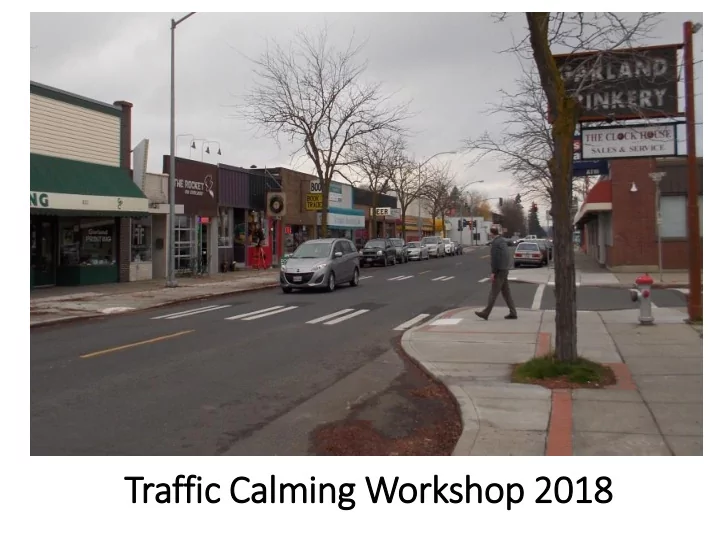

Traffic Calm lming Workshop 2018
Purpose of f Traffic Calming • Slow vehicular travel speeds • Reduce the frequency and severity of collisions • Reduce the need for police enforcement • Reduce residential cut-through motor vehicle travel patterns • Increase safety for non-motorized street users • Increase access for all modes of transportation • Enhance the street environment
Project Funding • Photo Red Light Funds – 15 red light cameras at 10 intersections throughout Spokane • Cameras implemented in 2008 • The program is a safety program designed to reduce red light violations and collisions in intersections. • Funding is expected to be available on an annual basis.
What the Program Funds • Traffic Calming Toolbox – Installation of • Traffic Control devices • Pedestrian and bicycle improvements • Physical roadway features • Transportation Studies • Project Designs
Traffic Calming Projects • There is not a single tool to solve traffic issues and one tool that may work well in one area for a particular issue may not be effective in another area.
Traffic Calming Projects • Traffic Island/Median • Landscaping/Street Trees • Bike Lanes • On Street Parking • Traffic Circle • Speed Display Board • Signage • Marked Crosswalk • Flashing School Zone Devices • Gateway
Project Se Selection Requirements 1. Each neighborhood can submit 1 residential and 1 arterial application. 2. Applications must be signed or have a signed letter from the Neighborhood Council chair to be eligible. 3. NC Meeting Minutes with a vote approving the applications need to be attached to the application. 4. Projects must be ranked 1 or 2 (projects should not hold the same ranking) 5. Project scope should stop at logical breaks 6. No sidewalks that do not have good connectivity 7. Consider the entire street and neighborhood when choosing projects, outreach to the membership.
Updated Application for 2018 1. Updated application: One application this year, just check the box if it is Arterial or Residential. 2. Please submit one project per application. 3. Residential applications require 51% approval signatures from the affected businesses and residents within a 400ft buffer of the project area. Please reach out to Katie Myers for a map and list of addresses of the affected properties. (kmyers@spokanecity.org). 4. Sidewalk projects no longer require the 51%/400ft buffer of signatures of support. Only a list of signatures stating that adjacent property owners have been informed of the sidewalk proposal.
2018 Program Ti Timeline arch 9 , 2018: 2018 Traffic Calming applications are 1. 1. Mar due. 2. 2. Spring 2018: Streets Dep. Collects Data and creates recommendations based of data. 3. Summer 2018: Staff makes recommendations to the 3. Council Traffic Calming Subcommittee. 4. 4. Summer 2018/Fall l 2018: Council Traffic Calming Subcommittee preselects projects for funding. 5. 5. Fall ll 2018: Full Council votes on projects for funding. 6. 6. 2020: Most likely projects are constructed.
New Sc School Sa Safety Program • New Program starting this year. • Program is funded by the school radar camera program. • Neighborhood Councils, City Staff, City of Spokane schools and any other citizen or community group can submit school project applications anytime throughout the year. • Project selection depends on funding availability, size of project and data collection. • Signature collection is NOT required for this program.
New Sc School Sa Safety Program • All applications will be reviewed and selected by the Council Traffic Calming Subcommittee. • Construction dates are dependent upon timing, size and data. • This too is a competitive process and not all submitted applications will be selected. • Project scope should stop at logical breaks • No sidewalks that do not have good connectivity • Consider the entire street and neighborhood when choosing projects, outreach to the membership
Project Traffic Assessment
Basic Analysis Process • Define The Problem • Is There a Realistic Solution? • Gather Facts For The Problem • Create Possible Solutions to The Problem • Review Possible Solutions and Select Your BEST Solution • Submit your BEST Solution
Past Project #1 • Maxwell and Elm Pedestrian Island and Crossing – Details • Over 5,000 cars per day traffic volume • Average speed was 28 mph – posted 30 mph • Seasonal 20 mph speed limit zone • Over 80 pedestrians in an hour when the pool is open – Project • Pedestrian refuge island
Past Project #1 • Maxwell and Elm Pedestrian Island and Crossing
Past Project #2 • Montgomery Traffic Circles – Details • Over 1,800 cars per day traffic volume on a residential street • Average speed was 18 mph – speed limit is 25 mph • Trinity Catholic School on Montgomery • No pedestrian collisions at Montgomery – Project • Traffic circles
Past Project #2 Montgomery Traffic Circles
Past Project #3 Whitman: Sidewalk infill on Rowan Ave with crosswalk into Rochester Park
Past Project #4 Lewis & Clark 20 When Flashing:
Questions?
Recommend
More recommend